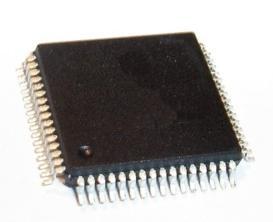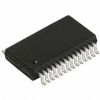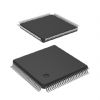DescriptionThe CY7C64613128NC belongs to CY7C64613 (EZ-USB FXTM) family, which using a 12-MHz crystal for low EMI. An internal oscillator and PLL develops an internal 48-MHz clock for use by the USB Serial Interface Engine and the 8051 microprocessor. The 8051 can run at either 24 MHz or 48 MHz, controlled by a bit in the EEPROM attached to the I2C-compatible bus. The default rate (with no EEPROM connected) is 24 MHz. The internal microprocessor of CY7C64613 is an enhanced version of the industry-standard 8051. Enhancements of CY7C64613 include four clocks per instruction cycle operation, a second data pointer, and an enhanced interrupt system. The 8051 includes two UARTS, three counter-timers, and 256 bytes of register RAM.
The features of CY7C64613 can be summarized as (1)single-chip integrated USB transceiver, serial interface engine (SIE), and enhanced 8051 microprocessor; (2)certified compliant with USB specifications 1.1 and 2.0 (full-speed device); (3)software operation: 8051 runs code from internal RAM or external RAM. Code can be: downloaded via US; loaded from EEPROM; executed in-place from external memory (e.g., Flash); (4)abundant endpoints and buffers: 14 bulk/interrupt endpoints, each with a maximum packet size of 64 bytes (per USB specification); 16 isochronous endpoints, with 2 KB of buffer space (1 KB, double buffered) which may be divided among the 16 isochronous endpoints; one control endpoint (bidirectional); (5)integrated, industry standard 8051 with enhanced features: four clocks per instruction cycle; 48-MHz or 24-MHz 8051, selectable by EEPROM configuration bit; two UARTS (115 K baud); three counter/timers; expanded interrupt system; two data pointers; (6)3.3V operation; (7)smart SIE: handles much of the low-level USB protocol in logic, simplifying 8051 code; (8)general programmable interface (GPIF): allows direct connection to most parallel interfaces: 8- and 16-bit wide; eliminates external glue logic in most applications; programmable waveform instructions and configuration registers to define waveforms; six ready (RDY) inputs and six control (CTL) outputs; (9)vectored interrupt system expanded for USB, FIFO flags and DMA interrupts; (10)separate buffers for SETUP and DATA portions of a CONTROL transfer; (11)integrated I2C-compatible controller: 400-KHz or 100-KHz operation; (12)enhanced I/O: I/O port registers mapped to 8051 SFRs (special function registers) for high-speed bit operations: port bits can be controlled using 8051 bit addressing instructions; Up to five 8-bit I/O ports; (13)four integrated 8-bit-wide FIFOs: Each 64 bytes deep; automatic conversion to and from 16-bit buses; easy, glueless interface to ASIC, DSP ICs and external logic; brings glue FIFOs inside for lower system cost; Internal or external clock; Synchronous (using strobes and a clock) or asynchronous (using strobes only); (14)DMA controller: moves data between slave FIFOs, memory, and ports; Very fast transfers-one clock (20.8 ns = 48 MHz) per byte for internal transfers; Can use external RAM as additional FIFO (accessed via Address and Data buses); (15)special autovectors for DMA and FIFO interrupts; (16)glueless external memory expansion: up to 16-bit address bus and 8-bit data bus; strobes RD#, WR#, OE#, CS#, and PSEN#; buses not multiplexed (as in standard 8051), saving one clock per external memory cycle; (17)three package options128-pin PQFP, 80-pin PQFP, and 52-pin PQFP.
The absolute maximum ratings of CY7C64613 are (1)storage temperature: 65°C to +150°C; (2)ambient temperature with power supplied: 0°C to +70°C; (3)supply voltage on VCC relative to GND: 05V to +40V; (4)DC input voltage: 0.5V to 5.25V; (5)DC voltage applied to outputs in high z state: 0.5V to VCC + 0.5V; (6)power dissipation: 500 mW; (7)static discharge voltage :> 2 kV ; (8)latch-up current: > 200 mA; (9)max output sink current: 10 mA; (10)TA (ambient temperature under bias) : 0°C to +70°C; (11)supply voltage: +30V to +36V; (12)ground voltage: 0V; (13)FOSC (oscillator or crystal frequency):12 MHz ± 0.20%.

 CY7C63221 Data Sheet
CY7C63221 Data Sheet







